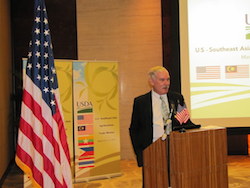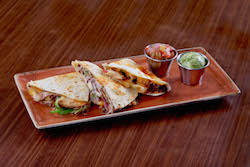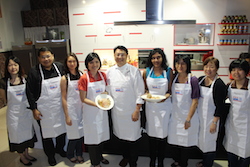| |
 |
March 2015 |
|
| |
| |
|
Welcome
Welcome to the seventh issue of the USAPEEC ASEAN Regional Office.
The newsletter seeks to provide readers with useful product and major market information for institutional and consumer users of U.S. poultry. Readers will find in every issue a variety of general market information, program activities as well as useful product information.
This month, we take a look at several market perspectives in the individual ASEAN countries.
Contents:
- Fast growing ASEAN market key focus of U.S. Agricultural Trade Mission
- U.S. Menu Promotion with Hard Rock Café
- Poultry education workshop to train the trainers
- Robots vs humans
- Duck is the new meat protein
|
|
|
| |
|
|
|
| |
|
Additional Market Information Available
We have updated our website to include more information on market reports and export documentation guidelines.
You can visit our ASEAN website at: www.usapeecasean.com |
|
|
| |
|
|
|
 |
|
Fast growing ASEAN market key focus of U.S. Agricultural Trade Mission
The U.S. Agricultural Trade Mission consisting of 21 agricultural exporters and six senior state representatives visited Kuala Lumpur on March 9 -10 as the first stop of their two nation tour in Southeast Asia. The ASEAN grouping is considered as one of the fastest growing markets as well as a key destination for U.S. agricultural exports.
In 2014, U.S. agricultural exports to ASEAN totalled US$11.4 billion, an increase of 6.3 per cent from 2013. Fast-growing agricultural exports to the ASEAN region include bulk commodities like soybeans, wheat and cotton, intermediate commodities such as animal feeds and semi-processed products and consumer-oriented products including dairy, prepared foods and fresh fruit products.
The trade delegation was led by Michael T. Scuse, Deputy Under Secretary, Farm & Foreign Agricultural Services, USDA. Kuala Lumpur was the first stop before proceeding to the Philippines. During the visit in Kuala Lumpur, the team was given briefings by U.S. Ambassador Joseph Yun, as well as by Chris Rittgers, Agricultural Attaché to Malaysia, Bobby Richey, Agricultural Attaché to Thailand, and other senior Embassy officials. The delegations members were briefed on the market opportunities for agricultural products in Malaysia, Thailand and Myanmar.
After the briefing, delegation members had the opportunity for one-to-one meetings with leading Malaysian importers as well as the delegation of Burmese traders who flew into KL for the event. In the evening, a reception was held to enable key Malaysian retailers, importers and food service operators to meet up with the delegation members.
|
|
Deputy Under Secretary Michael Scuse addressing participants in the 12th U.S. Asia Agri-Business Trade Mission to Malaysia |
| |
|
|
|
 |
|
U.S. Menu Promotion with Hard Rock Café
During the Christmas and New Year festive period, USAPEEC Singapore held a month-long menu promotion with Hard Rock Café. Two turkey recipes –roasted turkey quesadillas and chopped turkey salad - were specially created for the promotion.
Promotional materials produced for the event included flyers, banners, standees and mailers. The menu promotions were held at both Hard Rock restaurants in Orchard Road and in Resorts World Sentosa. The U.S. turkey menu promotion met with very encouraging responses from customers who were keen to try the new turkey dishes.
|
|
Roasted Turkey Quesadilla |
| |
|
|
|
 |
|
Poultry education workshop to train the trainers
USAPEEC recently held a poultry educational workshop at the EC Culinary Arts Studio, Temasek Polytechnic School of Applied Science in Singapore. The objective of the workshop was to train course instructors and young chefs on the quality, nutritional and safe handling aspects of U.S. poultry. A total of 15 course instructors attended the workshop. The workshop highlighted the nutritional aspects of U.S. poultry fed on a diet of U.S. corn and soybean.
Singapore celebrity chef Eric Teo who conducted the workshop demonstrated interesting and novel ways in the preparation and cooking of U.S. poultry in two unique recipes - roasted U.S. chicken breast wrapped in bacon, and poached stuffed U.S. chicken leg with lobster meat.
After the workshop, participants were more aware of the versatility of U.S. poultry.
|
|
Chef Eric Teo and participants in cooking demo |
| |
|
|
|
 |
|
Robots Vs Humans
Empty seats are seen in restaurants but diners were turned away. Why is this so? Turns out the restaurant was short-handed to serve the diners.
This has unfortunately become a familiar scene in Singapore restaurants. Restaurants are choosing to turn away customers rather than provide a half-hearted, inattentive experience for the diners. Their last resort has turned into a nightmare for the restaurants. In the midst of manpower shortage, Singapore F&B employers are looking at different ways to improve productivity in restaurants.
More restaurants are utilizing technology to cope with manpower shortage and rising cost.
Genki Sushi, a sushi chain in Singapore turned to robots and iPad minis to ease manpower crunch, speeding up service and productivity in the stores.
Machines are used to wash the rice, produce rice pallets for sushi, and place them neatly onto the plate. The food is delivered to the customers via a delivery system which is connected to all the tables in the store. The delivery system consists of a three-tiered track which sends trays of food from the kitchen to the tables. In line with the speedy theme, the trays are in the shape of Formula One cars and Shinkansen bullet trains.
Diners place their orders on the iPad minis and these orders are transferred to the iPads in the kitchen. Billing is also done via the iPads so the cashiers do not have to key the food items into the system again.
A Chinese fast-food chain, Ruyi, is also taking advantage of technology to improve productivity. Technology aids the staff in the form of a robot wok. The robot’s responsibility is to wok-fry dishes like noodles and rice. With this machine, the chefs would have more time to prepare other dishes.
As shared, technology can be useful in the F&B industry. However, not all restaurants are able to afford the investment in technology. Instead of turning to automation, they hope to attract employees with better’ benefits.
In a bid to attract and retain employees, Salad Stop!, a salad chain in Singapore has come up with a few ideas. An incentive scheme for job referrals was introduced. Employees who referred a friend who stayed for more than three months will get $150. They also have a flexi-work plan for housewives and older workers. Housewives can work 7am-to-2pm shift which are tailored to match school hours. They are also not required to work evenings or weekends. This will attract housewives who want to both work and be able to care for their children and family at the same time.
For workers above 55 years old, they work 35 hours per week and are able to choose their work timings. They also get a month of unpaid annual leave, bonuses and medical insurance, and are invited to staff social functions in addition to the flexible work timings.
The chain is also looking at how to improve productivity for the workers.
The owner is currently working on a new bottle design that will allow servers to dress salads more conveniently, scraping precious seconds off for a more efficient food/salad preparation process.
All in all, restaurants must be willing to adapt in order to cope with manpower shortage. Adopting technology and tweaking human resource policies are two feasible ways restaurants can utilize to improve productivity.
|
|
iPad menu and delivery tray at Genki Sushi |
 |
|
Duck is the New Meat Protein
Duck has been a popular choice of meat in Asia since the Chinese domesticated it thousands of years ago. Duck meat is a popular choice amongst many as a source of healthy protein and fats. Duck also contains an abundance of iron, phosphorus, zinc, copper and more1.
Apart from duck meat, duck fat is also utilized by many. There are an increasing number of foodies and restaurants who switched to duck fat as it is considered a healthy alternative to using beef fat, pork fat or even butter to fry food. In comparison to beef fat, duck fat has 17% less saturated fat.
Duck contains more iron per serving than any other meat, including many cuts of beef. However, duck meat contains more cholesterol than beef. Even so, consumers can maintain an adequate intake of nutrients by adjusting their food intake to avoid excessive fats, cholesterol or calories.
Nutrient content of 100 gram edible portions of various parts of duck (domesticated, meat only, raw) and beef (cured, corned beef, brisket, raw) |
Nutrient |
Unit |
Duck |
Beef |
Energy |
kcal |
135 |
198 |
Protein |
g |
18.28 |
14.68 |
Fat |
g |
5.95 |
14.90 |
Carbohydrates |
g |
0.94 |
0.14 |
Calcium |
mg |
11 |
7 |
Iron |
mg |
2.4 |
1.69 |
Magnesium |
mg |
19 |
14 |
Sodium |
mg |
74 |
1217 |
Zinc |
mg |
1.90 |
2.85 |
Potassium |
mg |
271 |
297 |
Phosphorous |
mg |
203 |
117 |
Cholesterol |
mg |
77 |
54 |
Source: U.S Department of Agriculture
Duck is used in a variety of dishes around the world. A few common dishes in restaurants are, Roast Peking Duck, duck confit and duck risotto. Duck confit and duck risotto originate from the West but they are very popular in Asia. Roast Peking Duck is a famous Chinese dish from Beijing, and it is prized for its thin and crispy crust. It is often a must-have dish during celebrations.
Apart from duck meat and fat, their eggs are also included in many recipes. The salted duck egg is an extremely popular example. It is a Chinese preserved product which is made by soaking duck eggs in brine, or packing each egg in salted charcoal.
Salted duck eggs are usually boiled or steamed and go well with porridge. The egg white is salty and the orange egg yolk is rich and fatty. The salted duck egg yolk has several uses. It is included in rice dumplings and Chinese mooncakes to symbolize the full moon. It is also used to make the sauce for zichar dishes (wok-fried Chinese dishes) like pork-ribs and crabs.
In Singapore, more and more restaurants are incorporating salted duck eggs into their dishes. The result is an array of intriguing dishes such as salted egg ice cream, salted egg custard lava cake, charcoal waffles drizzled with salted egg yolk sauce and seafood pizza slathered with salted egg mayonnaise. Some of the places to find these dishes include Five & Dime, Fatcat Ice Cream Bar, Sin Lee Food and more.
Some restaurants have started introducing salted egg-infused dishes as a mystery item on the menu! These have become permanent menu items as more orders and positive feedbacks were received.
Due to the surging popularity of salted duck egg-infused dishes, egg suppliers have noted that there is a growing demand for salted duck eggs from eateries. In the past, orders for salted duck eggs only surged during the festive month of May (rice dumplings) and August (moon cakes). Sales of salted duck eggs are now consistent all year-round.
1Source: Duck Research Laboratory, Cornell University, College of Veterinary Medicine, Population Medicine and Diagnostic Sciences |
|
U.S Roast Duck |
|
You have received this email because you have registered to get newsletters from USAPEEC ASEAN.
If you prefer not to receive these updates, please
click here
to unsubscribe.
Do not reply to this email. For enquiries, go to www.usapeecasean.com
® USA POULTRY & EGG EXPORT COUNCIL
541 Orchard Road, #15-04, Liat Towers, Singapore 238881 Tel: (65) 67371726 Fax: (65) 67371727
*|REWARDS|* |
|
|
|